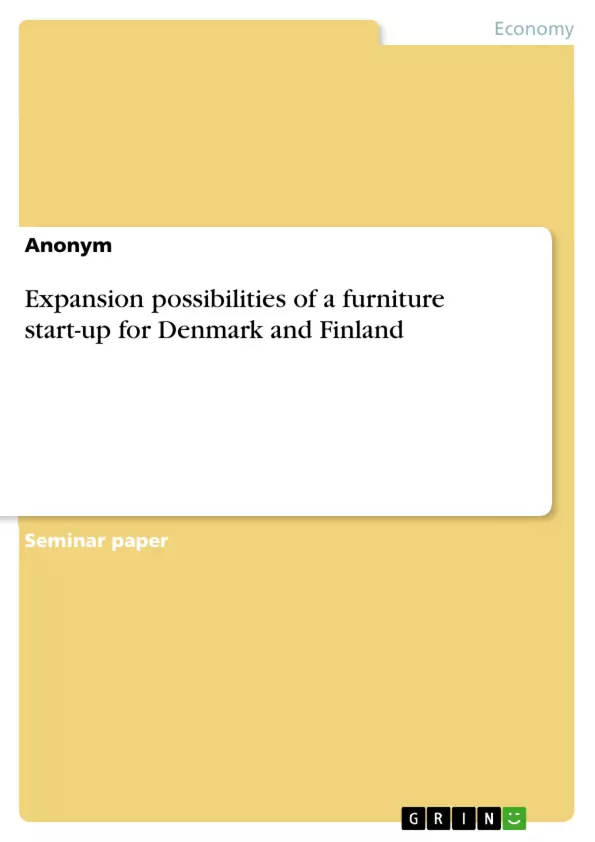In the following, an in-depth analysis of the suitability of entering the Danish and Finnish markets will be exemplified. In so doing, first the company OKINLAB GmbH will be presented. After that, the countries Denmark and Finland will be investigated in regard to the above-mentioned aspects. In the penultimate chapter, a SWOT-analysis will be elaborated for both Denmark and Finland. Derived from the SWOT-analysis, possible scenarios for an internationalization will be presented. Finally, this elaboration will be completed by a conclusion.
Imagine a shopping experience in which you see, feel and live the piece of furniture you would desperately like to buy. And as if this wasn't enough, the fancied product does even match perfectly the structural peculiarities of your house, flat or room. And now think again, this whole new level is far from unreal, in fact such a model does already exist in a similar way and will be under constant development and adaptation as time goes by. The German enterprise OKINLAB GmbH (form.bar) does provide customized solutions when it comes to pieces of furniture of nearly all types. After successful operations within the German market, the firm aims to target a foreign market in Northern Europe.
Being mostly driven by consumer spending, the furniture market is under continuous growth. Steady increases in disposable income and a high level of living conditions cause the market to maintain its strength. Related to this is therefore a constant demand for furniture. Challenges and opportunities though pose the new way of shopping and the change of consumer behaviour. Especially seen in relation with a relentless technological evolution that redefines human life, future challenges have to be observed from a totally new perspective.
Inhaltsverzeichnis (Table of Contents)
- Introduction
- Company presentation OKINLAB GmbH
- History of the company
- Form.bar product and customer
- Status quo of internationalization
- Country portrait: Denmark
- Market characteristics
- Customers
- Competitors
- Distribution channels
- Country portrait: Finland
- Market characteristics
- Customers
- Competitors
- Distribution channels
- Recommendations for an intended internationalization
- SWOT-analysis Denmark
- SWOT-analysis Finland
- Possible scenarios for an internationalization
- Conclusion
Zielsetzung und Themenschwerpunkte (Objectives and Key Themes)
This analysis aims to evaluate the potential expansion of form.bar, a product developed by OKINLAB GmbH, into the Danish and Finnish markets. The study provides a comprehensive overview of the target markets, analyzing market characteristics, customer profiles, competitive landscapes, and distribution channels in both countries. It also includes a SWOT analysis for each market and outlines potential scenarios for the internationalization process.
- Market analysis of Denmark and Finland
- Customer segmentation and identification of target audiences
- Competitive landscape and competitor analysis
- Distribution channels and strategies for market entry
- Evaluation of potential risks and opportunities for internationalization
Zusammenfassung der Kapitel (Chapter Summaries)
The report begins with a company presentation of OKINLAB GmbH, outlining the history of the company and its product, form.bar. It then delves into the status quo of form.bar's internationalization process. The subsequent chapters provide detailed country portraits for Denmark and Finland. Each country portrait examines market characteristics, customer profiles, competitive landscapes, and distribution channels. Finally, the report concludes with recommendations for an intended internationalization strategy, including SWOT analyses for both markets and possible scenarios for implementation.
Schlüsselwörter (Keywords)
The report focuses on key terms like internationalization, market analysis, customer segmentation, competitor analysis, distribution channels, SWOT analysis, and potential scenarios for internationalization. The study also incorporates specific industry terms relevant to the form.bar product and its target markets, such as eCommerce, product types, and distribution channels.
- Quote paper
- Anonym (Author), 2020, Expansion possibilities of a furniture start-up for Denmark and Finland, Munich, GRIN Verlag, https://www.grin.com/document/539281



